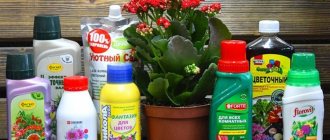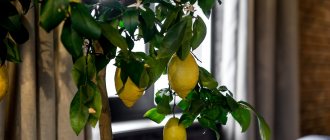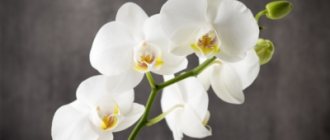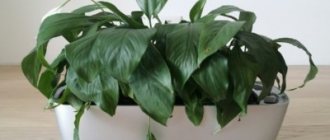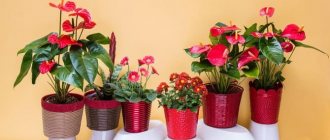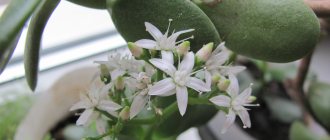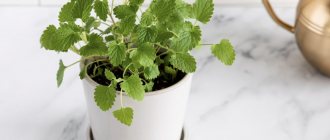Too much water
Flowers need to be watered regularly, but many people simply “water” them until they die. There are only a few types of indoor plants that should be constantly in water, for example, Egyptian papyrus. Usually, too much water has a bad effect on the roots of plants, they cannot breathe, and the process of rotting begins.
In addition, sometimes flower owners simply do not know that there is still enough moisture in the ground. Maybe only the top layer has dried: you can check this with a wooden stick. If there is water in the soil, soil will remain on the stick, and if it is completely dry, then the plant can be watered.
You shouldn’t overdo it with the amount of water either: it’s better to pour it so that it evaporates or is drunk by the plant in a quarter of an hour. We must remember that plants with large leaves require more water.
Is it possible to give flowers from house to house?
All old plants that no longer bloom or produce new shoots should be thrown out. Sick flowers should not be kept in the house, as they will take away your health. A flower that you have been caring for for a long time, but all your actions are of no use and it fades, should also be removed from the house.
Interesting materials:
How many cables are there in one nautical mile? How many calories are in 1 fig? How many calories are in 10 almonds? How many stones are there in a watch? How many holidays are there for the New Year? How many Kazakhs are there in the whole world? How many Kazakhstanis were awarded the title Hero of the Soviet Union? How many kg are in 1 MPa? How long are undelivered messages stored on WhatsApp? How long are vacation orders kept in the archive?
What causes houseplants to wilt?
Even the most attentive and ideal housewives have indoor plants that die. Below we will look at the main reasons for the “poor health” of flowers.
Temperature stress
Flowers in an apartment often wither when the heating is turned on or off, and also if there are large temperature changes outside. Try to protect plants as much as possible from temperature fluctuations, use heat, air conditioning and a humidifier to maintain a comfortable environment for plants in the house.
Drying out
If the apartment is hot, the flower may not have enough water as indicated in the “instructions”. Focus on the condition of the soil in the pot and water the plant more often if necessary.
Overmoistening
Even more destructive for a plant than a lack of moisture is its excess. In this case, the roots often begin to rot, and the flower cannot be saved. Therefore, try to carefully monitor the watering regime, taking into account the individual needs of the plants.
Low humidity
Flowers are more sensitive to air humidity than people, and respond to a lack of this parameter by wilting. If your apartment has low air humidity, purchase a humidifier: it will be useful for both you and the plants.
Parasites
Carefully inspect the flower: if you see any mechanical damage (holes, torn edges of leaves or stems, scratches), it is possible that indoor plants are dying because pests have become interested in them. For each type of pest, you can find a special remedy in the store that will help save the flower.
Problems with fertilizers
For each flower, it is important to choose the right fertilizers for it, because there are “capricious” plants that require an ideal balance in temperature, watering and soil content, and there are unpretentious ones. Read more about the flowers that are in your home to find out how to properly care for them so that they please the eye for as long as possible.
The influence of poor energy in the house on plant growth
We generally believe that plants do not take root in a house with poor energy, and this is true. Not only flowers, but also the person himself will not be able to live safely in it.
It often happens that all the conditions for caring for plants are met perfectly, but the flowers in the apartment still wither. This is especially noticeable if there have never been problems with the plants, and then for unknown reasons - for example, when moving to a new apartment, they began to rapidly wither. In such cases, the problem may be negative energy in the house, because plants are the first to take the blow. It is recommended to periodically carry out energy cleaning of the apartment, on your own - if you feel the strength and potential, or with the help of an expert who works with energies.
Took on the negativity
Sometimes the cause of poor health of plants is not the walls of the house, but the person himself, or rather, the negative impact on him. The wilting of flowers in this case indicates that they have warded off some kind of misfortune, illness, and thus took on the troubles so that the person does not suffer.
Plants “draw” human ailments onto themselves. Therefore, only healthy, not wilted plants should be kept at home. Dried flowers do not carry positive energy; they emit the energy of old age, illness and negativity.
Plants that are considered “female” are especially sensitive in this regard. There is, for example, the spathiphyllum plant, which is popularly called “female happiness,” “female flower,” or “flower of love.” If its leaves wither, then something is wrong with the energy of the hostess. If a plant does not bloom for years, there is a risk that its owner will not be able to realize herself in the “female line” - as a wife, mother, etc.
There is no point in reviving such plants. You should thank them for their role and bury them away from home. To get rid of this problem, you need to conduct an energy cleansing of the room with an expert.
The houseplant is withering. What to do?
A houseplant wilting is a major sign that potted flowers are having trouble. They lose their healthy appearance, the castings wilt, even the color may change - all this may indicate a number of problems associated with unsatisfactory care or emerging diseases.
The main sign that potted house flowers are having trouble is a wilted appearance.
For what reason can a flower fade?
This sign in itself does not provide any specific information about the existing problem, so it is difficult to say the exact cause of wilting. Individual plants, like representatives of the same species, can dry out, turn yellow and lose vitality for various reasons; this process is very individual. Therefore, it is very difficult to specify the situation and take appropriate measures to eliminate its poor condition and bring the vegetation back to its previous healthy state.
Individual plants, like representatives of the same species, can dry out, turn yellow and lose vitality
The wilting depression should not be confused with the natural periodic partial yellowing and shedding of leaves, as this is an integral part of the life cycle. This includes: bushes and trees that shed their leaves, vegetation that sheds all greenery completely, being in a state of complete dormancy, for example: cyclamen, anreder, begonia with a tuber root system, caladium and others. Incomplete fall of foliage occurs in fuchsia, jasmine, koleria, camellia and synningia, but the change in color to yellow in these specimens indicates that the vital activity process is reduced. The same condition is also typical for wilted bracts in poinsettia, or complete death of the lower rows leaves during maturation in palm species. Before you begin to find out all the reasons, you need to study each existing home vegetation and learn to distinguish the natural course of things from poor care, diseases or harmful insects.
If you think that your homemade greens have begun to dry out, you need to inspect and determine the progress of the process:
- The first signs are drooping leaves that have lost their juiciness, slow growth, pale color and a general appearance of weakness. This may also indicate insufficient watering, but what is meant here is that the depressed state persists even when the soil in the pot is sufficiently moist. Such symptoms will not indicate the presence of a problem, but will make it clear that a particular specimen requires special supervision.
- Unnatural weakening can occur with increasing decline in vital processes, when the overall appearance ceases to be decorative, but there are no other symptoms present, for example, leaves do not change their color or obvious signs of disease, which cause such a sluggish state.
- A complete change in color, partial, or a change in shade when it becomes more faded on the leaves or stems - this characterizes secondary signs that already signal serious troubles and their causes. This refers to the process of destruction of chlorophyll and failure of photosynthesis and metabolism. This is why it is important to monitor flowers regularly.
Store-bought flowers die. Why?
You can often hear complaints from amateur gardeners that purchased potted plants die at home. This actually happens often.
Let's look at the main reasons for the death of purchased indoor plants and determine what to do to prevent this.
Dutch substrate
Flowers imported from abroad do not grow in the soil most suitable for them, but in a special transport mixture. This applies not only to plants from Holland; it’s just that many potted flowers are supplied to our market from there.
The use of a transport substrate is a mandatory requirement of quarantine services, otherwise the cargo will not cross the border. This requirement is based on the fact that dangerous pests and pathogens of plants are not imported into our country along with the soil. The transport mixture in this regard is clean.
But each flower in its historical homeland grows in its own type of soil with different acidity, air permeability, friability, and moisture retention. A substrate for transportation that is the same for everyone does not meet the requirements of growth; it is needed only to prevent the import of parasites into the country.
The mixture for transportation is based on coconut fibers or peat. Such soil dries out instantly.
Naturally, plants that naturally grow on peat can also grow in this substrate. Others need completely different soil. It is clear that if you bought a flower in such a substrate and did not replant it, it will not last long. Especially if the plant was overdried during transportation.
Stimulants
Why do plants bloom and smell fragrant in flower shops even in Dutch shipping soil? The answer is simple - because stores very often use fertilizers and stimulants.
Growth stimulants are not harmful. On the contrary, they help the plant adapt, take root better, and survive the stress of transportation and its consequences. But! It must be remembered that you cannot keep the plant on stimulants all the time. You cannot always intensify growth and development, because at some point this will lead to the flower devoting all its energy to flowering and dying.
Therefore, when you bring a plant into your home, replant it. And use stimulants only once, if necessary. For example, Heteroauxin is for better rooting during planting, and Epin is for protection from stress.
Stress protection and mindfulness
Sometimes the actions of the buyer himself lead to the death of the plant. Long-term transportation, stress from constantly changing places after purchase - all this has a detrimental effect on the plant.
You need to be especially careful when transporting flowers in cold weather. Standing at a bus stop with an unpacked croton in the cold wind or holding a cordyline with open leaves in the snow while you get home is not worth it. Otherwise, don’t be surprised that the plant died.
Attentiveness means knowledge of the requirements for growing conditions and correct care and replanting.
After purchasing a flower, inspect it for pests.
During transplantation, check if there is any mesh on the roots! This phenomenon occurs in purchased plants. A small seedling or cutting is grown in a small container with a lump of earth in a net. Then the grown plant, together with the mesh, is sent into the transport soil and transported. By a certain time, the mesh begins to restrict the roots so much that they begin to die. Therefore, during transplantation, do not forget to shake off the transport mixture and inspect the roots for the presence of mesh. If it is not removed, cut it.
What else to consider during transplantation.
Know that for ease of care you can now use hydrogel. It is especially suitable for moisture-loving flowers. This polymer compound absorbs large volumes of water, absorbing it into the granules. Water or a nutrient solution with microelements is given (depending on what you fill the granules with) then gradually. The hydrogel can be added to the substrate during transplantation and reduce the hassle of watering.
The basic rules for transplantation are:
1. Mandatory compliance with the requirements of a particular plant. Orchids are transplanted into soil consisting of pieces of bark; for cyclamens, the soil should not be heavy or waterlogged, etc.
2. When you yourself prepare the substrate for replanting, know that all parts of the soil must be “ripe”. That is, it is unacceptable to use immature humus or insufficiently rotted turf soil.
3. The soil must not contain toxic substances.
4. After replanting, do not move the plant from place to place for some time, let it adapt.
And in response to your care, the purchased potted flowers will bloom not only in the store, but also in your home. And, of course, they won’t die immediately after acquisition either!
Too little water
However, it also happens that plants are not watered enough. In addition to succulents, this has a detrimental effect on their health, because most plants cannot store large amounts of water for a long time. Sometimes you can save a dried out plant. You just need to lower the container with the flower into a bucket of warm water for a few minutes. Perhaps the plant will absorb moisture and come to life. It’s also worth remembering that you don’t need to water the flowers with tap water; it’s better to use liquid at room temperature that has already settled.
What crops can be grown at home?
There are many signs and legends about indoor flowers. And this is not something strange or unusual for knowledgeable gardeners.
For example, in pre-war times, ficus could be found in every home; it was considered the main symbol of prosperity and a happy family life. But after the war it was called the “widow’s flower”, mourning the dead.
Indoor crops that bring money
For financial prosperity, it is recommended to keep flowers at home that attract money and success. There are a sufficient number of varieties of such plants.
Among them is the well-known money tree or Crassula. It can be found in most homes. The oval leaves, falling off, become silvery in color, making them look like coins. If you pinch off a small shoot in the house of rich people and plant it in a red pot, then monetary luck will always accompany you.
There are other flowers, for example:
- fragrant geranium;
- homemade lemon;
- Zamioculcas (dollar tree);
- Dracaena Sandera or bamboo of happiness;
- pachira;
- scindapsus;
- bougainvillea.
Important! Before choosing a flower, make sure that it does not have other signs that do not suit you at all. For example, scindapsus attracts money, but is considered a “husband” flower. Therefore, married people are in danger of being left without a soulmate.
About profitable plants in the video:
Plants that bring family well-being
Many people want to find prosperity in their personal lives or change their marital status, for example, to get married. Therefore, they are advised to purchase flowers for their home that will attract their loved one.
These can be the following plants:
We recommend: What signs exist about violets and can you keep them at home? Meaning and magical properties
- spathiphyllum - a flower of “female happiness”, brings success in love and brings a loved one into the home;
- anthurium – “male happiness”, gives strength and love energy to men in the marital bed;
- oxalis - protects the family from divorce, single people will meet their soulmate;
- calathea - a blooming indoor flower is a symbol of a happy family life; according to popular belief, among quarrels - it dies and withers;
- aichrizon - protects the home from worthless and evil people, with this plant success and good luck come to the house;
- myrtle - an evergreen indoor tree symbolizes strong love for many years, so it can be accepted as a gift, for example, as a gift to newlyweds;
- chlorophytum - refreshes the air in the room and the relationship between lovers who have lost interest in each other;
- violet is a symbol of harmony, mutual understanding and affection.
About flowers that bring happiness to the home in the video:
According to popular superstitions, attracting health
There are plants in nature that can influence human health. They not only decorate the interior of a room, but also enrich the room with oxygen, emit a healing smell, attract health and protect against viruses and bacteria.
What plants to grow on your windowsill:
- aloe and Kalanchoe - seeing flowering promises a quick recovery from a chronic illness;
- geranium - attracts health, luck, well-being in the family, so it is recommended to place a flower pot in the bedroom, children's room or living room;
- hibiscus – has an effect on the cardiovascular system;
- dracaena – normalizes the functioning of the gastrointestinal tract;
- Decembrist - calms the nervous system, normalizes kidney function;
- hydrangea – promotes weight loss and the formation of a beautiful, slender body.
Adjust watering
Inexperienced flower growers most often lose their flowers due to mistakes when watering. You often hear the question - how often to water, how many times a week? And some gardeners advise - once a week or two, or every other day. This is wrong. You cannot give such recommendations in absentia.
The reasons why the soil in a pot dries quickly or slowly can be very different:
- humidity in the room - if the air is dry, the soil will dry out faster;
- air temperature - in a cool room you can water less often;
- pot material - in clay containers the soil dries out quickly, in glazed ceramic containers - a little slower, and in plastic containers - even slower.
Therefore, the best advice is to water when the top layer of soil dries, then the midges will not appear. And there are not very many indoor plants that love water in large quantities, such as cyperus.
The leaves will tell you about watering errors - if there is too much moisture, the lower leaves turn yellow and fall off, and if there is too little, they wither.
Excess moisture
Some people believe that “underwatering” a plant can be much better than “overwatering”. This is partly true - flowers get oxygen through their roots, and if you flood a flower, you will simply destroy its food source.
Signs of excess moisture: yellowed lower leaves, greenish soil and a slightly wilted plant that is drooping. It is better to water the flower only when the soil in the pot is completely dry.
Incorrect placement in the room
Another reason for the poor condition of indoor flowers may be their improper placement in the room. You may have placed a shade-loving plant in the brightest spot. Or, on the contrary, they pushed the pot with the light-loving inhabitant onto the very top shelf, where there is rarely light.
The appearance of the plant will tell you that you are doing something wrong. If the leaves have turned pale and thinned, and new buds do not appear or fall off before they have time to bloom, it’s time to move the pot closer to the light. Slow growth, dull, pale leaves that periodically turn yellow and fall off can signal that your shade-loving plant is “overheated” in too much light.
Pests
If you notice that your plant has begun to wither before your eyes, but you have not changed the conditions of its maintenance, then perhaps the flower is affected by pests. Unfortunately, there is no universal means of combating parasites; each type may require a separate medicine.
Indoor plants decorate the interior of the room and delight the eye with their appearance. Despite all these benefits, you should remember that there are dangerous flowers that can poison the human body.
Causes of yellowing leaves
Indoor flowers and plants for a gardener, like pets for a breeder, are a lot of investment, effort and time, and besides, they are the gardener’s pride, an indicator of his knowledge and skills. Yellowing of the leaves of indoor plants causes frustration and disappointment, especially if everything was fine until that moment, and then suddenly changed. Meanwhile, there are not so many reasons for yellowing of leaves, and they are all divided into four functional groups:
- violation of the conditions for keeping indoor plants;
- violations of the care of indoor plants;
- damage to a houseplant by a disease;
- attack on a houseplant by pests.
Let's take a closer look at each of these groups and find out what to do to prevent this problem from affecting our plants.
Violation of the conditions for keeping indoor plants
The concept of plant agricultural technology includes a set of rules for caring for indoor plants. Among these rules, the conditions for growing a houseplant are always clearly stated. Violation of these conditions leads to the expected problems: the leaves turn yellow, dry out, and the flower begins to hurt. I recommend studying violations in the maintenance of indoor plants that cause yellow leaves.
- Lack of lighting. Examine the plant carefully. A lack of lighting is characterized not so much by yellowing of the leaves, but by their loss of color, acquired pallor, and the shoots stretching upward in search of a light source. In this case, move the pot with the indoor plant to the south windowsill.
- Direct sunlight. Contrary to the belief that all flowers love the sun, it is important to know that most plants require shading. Direct rays cause sunburn of leaves; in this case, yellow spots will be located only on the window side. The solution is the same: change the location or hang a thin curtain on the window.
- Draft in the room. Unlike garden plants, indoor flowers are not adapted to wind and air movement. It’s easy to check the reason: if the leaves turn yellow on a plant standing under an air conditioner or near an open window, look for a new place for the flower.
- Temperature difference. Like a draft, a sudden change in temperature, a jump in degrees in one direction or the other, can cause leaves to turn yellow. The problem can be fixed, but it will take time and patience: leave the plant alone and protect it from temperature fluctuations.
- Cold surface. This often happens in winter, when a flower stands on a windowsill, heated by a radiator, and its leaves touch the icy window. The situation is dangerous because it is impossible to restore overcooled leaves; they die and rot. Remove diseased leaves and move the pot away from the window.
- Wrong pot size. If the pot is large, moisture stagnation forms in the free space of the soil, causing rotting of the leaves of the indoor plant. If the pot is small, the flower will not have enough nutrients. Choose the right pot for your indoor plant. For the same reason, the leaves of a plant in a pot without drainage holes turn yellow.
- Mistakes in choosing soil for indoor plants. Using a universal soil for all types of plants is fundamentally wrong. Each plant requires its own qualitative and quantitative soil composition. Follow the recommendations for growing a particular plant.
- Low air humidity. This problem is typical for tropical plants that are accustomed to high humidity. Buy a humidifier or place the pot on damp expanded clay or moss.
Problems with caring for indoor plants
Now let's turn to violations in the care of indoor plants.
- Incorrect frequency and volume of watering a houseplant. Excessive watering provokes stagnation of moisture, which causes rotting of the root system of the indoor plant. Lack of watering dries out the roots, cutting off the supply of food to the plant. In the first case, you will need to replant the indoor plant and remove the affected roots; in the second, you will need to increase the frequency of watering.
- Incorrect watering. Irrigation problems are a broad topic; yellowing of leaves can result from using the wrong water. If watering is carried out with hard tap water, the yellow leaves will also begin to dry out. Let the water settle before watering the flower.
- No transfers. The plant may be cramped in the pot, or the soil may have become so poor that it affects the color of the leaves of the indoor plant. Replant the flower in new soil and pot.
- Malnutrition of a houseplant. A lack of mineral fertilizers is easy to recognize: if you do not feed the plant, there is not enough nutrition. An overabundance of fertilizers is even more dangerous, since the resulting chemical burns to the roots are not restored. In the first situation, increase the feeding; in the second, stop completely and wait until the plant comes to its senses.
Infection of a houseplant with a disease
Among the diseases of indoor plants, there are also several causes of yellowing leaves.
- Fungal infection of a houseplant. Fungal diseases that cause yellowing of foliage are physaria, late blight and anthracnose. The advantage of a fungal disease is that it is not resistant to treatment. Plants affected by fungal diseases must be treated with fungicide solutions, and after some time repeat the treatment, following the instructions on the package.
- Viral infection of a houseplant. In this case the situation is more sad. There are no cures for viral diseases; the affected parts of the plant must be removed and taken outside the apartment. Treat the remaining parts of the plant and all neighboring plantings with an antiviral prophylactic agent in the dosage specified in the instructions.
Pest attack on a houseplant
And the final group of reasons for yellowing of leaves is associated with the appearance of insect pests on plants. The yellowness of the leaves due to insects is due to the fact that insects feed on the juices of the plant, which is why the flowers lose their richness of color. Insects that love to feast on plant sap include spider mites, aphids, whiteflies and thrips. Ways to combat yellowing leaves obviously involve driving pests out of the pot. There are two methods for this: chemical and physical. Treating indoor plants with insecticides will protect the flowers from re-invasion, but it is important to understand that chemicals are not recommended for use in a residential area. The physical method is to collect insects from the plant by hand, and regularly wash the leaves with a solution of laundry soap, the aroma of which prevents many insect attacks.
In almost every home, a place of honor on the windowsill is given to indoor plants. However, sometimes they begin to wither for no apparent reason, grow poorly or die. So why don’t indoor flowers grow in the apartment?
Possible causes of death of indoor plants
Slowing growth or death of indoor flowers can sadden any gardener. To prevent the problem, it is worth familiarizing yourself with the possible reasons for the deterioration in the health of flowers. The article will talk about the probable causes of slow growth and death and methods of combating them.
The death of green pets can be caused by a number of factors. The most dangerous and common include the following.
Diseases
Dark spots on the leaves, lethargy and dryness may indicate the presence and development of the disease. The most common are: powdery mildew, mosaic disease, anthracnose, septoria and others. They occur as a result of infection by fungi or viruses. If proper measures are not taken, they can lead to death.
Pests
If the stem begins to wither, mucus appears on the leaves or traces of punctures are found, this may indicate damage by harmful insects: thrips, aphids, mites and others.
To prevent this, it is recommended to carefully monitor the condition of flowers and not place recently purchased flowers in close proximity to other representatives of the home garden for some time.
Contaminated air
During the process of respiration, flowers absorb carbon dioxide and produce oxygen. However, too much air pollution can lead to disruption of breathing processes. This problem occurs especially often in plants located on the windowsills of apartments in megacities. The abundance of exhaust gases that are absorbed by green filters often leads to a deterioration in their health and drying out.
Failure to comply with care rules
Plants, like people, have a number of characteristics: some like abundant watering and diffused light, some like low humidity and bright light. Before placing a flower on a windowsill, you should familiarize yourself with these features, because a flower placed in unsuitable conditions may die.
Abundance of chemicals applied to the soil
Often this problem concerns flowers that were purchased in stores. Thus, a large amount of fertilizer can be addictive and if it gets into another environment, the lack of such fertilizing can lead to drying out.
The reasons why flowers die in an apartment can be different: from pests to poor environmental conditions. However, if the plant suddenly begins to wither, you should pay attention to this, since lack of proper care can lead to death.
Unsuitable place for the plant
Unsuitable place for the plant
In the article mentioned above, you will find tips on how to properly place plants in your apartment, because without enough light or, conversely, with too much light, at best they will lose their appearance, and at worst, they will die.
Elongated stems, small leaves, poor growth, green leaves instead of variegated ones are external manifestations of a lack of light.
In addition to light, the health of indoor pets is affected by temperature and humidity. Where you decide to place the plant, they should suit its needs. Particular attention should be paid to this issue in the cold and dark season, think about additional lighting and a cool place. In winter, in room conditions, it is easy to overheat and dry out a plant, and at elevated temperatures, the development of most plants slows down.
Also, during the period of central heating in winter or in hot weather in summer, humidity sharply decreases, which is detrimental, for example, to tropical plants. A lack of moisture is indicated by leaves damaged at the edges, their dry tips, falling leaves, buds and flowers, as well as their change - shiny leaves become dull.
Can all species be grown in an apartment, and which ones cannot?
Folk signs warn which flowers cannot be grown at home. Some of them are poisonous and make people feel unwell. Others have negative energy and contribute to quarrels, family discord and even divorce.
We recommend: A flower with positive energy is begonia. Signs and superstitions about the presence of a plant in the house
When growing indoor plants at home, they need to be replanted, cuttings separated, and dry or damaged leaves and branches removed. There is close interaction with them.
But in nature there are poisonous flowers that are dangerous to humans and cannot be grown in your home:
- Dieffenbachia . The sap of the plant is very poisonous. When a part of a flower is cut or damaged, it releases toxic substances into the air. This can lead to poor health.
- Oleander . A flower with beautiful buds contains hot juice. A small drop will cause a skin burn.
- Euphorbia . According to signs, all types of this plant are not recommended to be grown at home. Sharp spines and juice, which causes allergies and irritation - all this makes it dangerous.
- Mimosa bashful . Releases toxic substances into the air. If you constantly touch its leaves, a person’s hair will soon begin to fall out.
- Spathiphyllum . The sap of the plant burns the skin and causes ulcers.
- Pachypodium . Provokes an allergic reaction, difficulty breathing.
- Lily . It is not recommended to keep it in the bedroom, because the flower emits carbon dioxide. The next morning the person feels a severe headache.
- Ficus . The evaporation of smooth leaves causes allergic shortness of breath and suffocation in humans.
- Hydrangea . Allergy sufferers should not keep it at home, because the flower buds emit a smell that provokes a dry cough.
All plants that have sharp leaves, thorns, and needles have a negative energy field. It is believed that they are the ones who bring scandals, quarrels, and misunderstandings into the family. An exception is that flowers with soft needles can be kept at home.
According to signs, some flowers should absolutely not be kept in the house, for example:
- Bonsai . A dwarf tree grown at home will hinder the financial and career growth of its owner. This flower is appropriate to keep in the office.
- Cacti . Unmarried girls should not be kept in the house. In married couples they provoke scandals and quarrels.
- Monstera . This is a powerful energy vampire. The person feels constant fatigue and irritation.
- Orchid . It is popularly believed that this plant is “muzhegon”. It takes away male power, feeding on positive energy in the house.
- Sansevieria . The flower drives away suitors from the house of an unmarried woman.
We recommend: Ikebana - pleasant memories or unexpected danger? Is it possible to keep dried flowers at home?
About which flowers should not be kept in the house and why, in the video:
Too much light
As with water, it should be remembered that direct sunlight in large quantities can be harmful. For example, whimsical orchids love diffused light; standing directly on the window all day long under the scorching rays of the sun, they can “get sunburned.” Orchids are best placed on the east side.
You may be interested in: What Haworthia looks like, popular varieties with descriptions and photos, ways to grow a flower at homeCrassula and tips for growing a flower at homeWhat a Chinese rose looks like and the secrets of growing and caring for hibiscus
Rational explanation
If everything is fine at the mental level, but the flowers still continue to die, then the problem may be due to a number of factors.
For example, the soil is not suitable for them. Each species requires its own type of soil, and if it is not chosen correctly, the plants can feel sick and even die.
Excessive or improper feeding can also be harmful. An excess of nutrients is no less harmful than their deficiency, and sometimes even more.
Perhaps the pot is not suitable for your plant: the roots simply do not have enough space in it, and the flower dries out.
Another reason for poor growth can be either pests or improperly selected conditions. Watering too often or too rarely. Humidity is too high, or, conversely, lower than necessary. It may be that your home flora is not getting enough light.
There is also the possibility of purchasing a plant from a poor location where it has not been cared for or used too many toxic chemicals. In particular, this problem occurs after purchasing in large supermarkets, where anyone can touch the flower, but there is simply no natural light.
Symptoms and problems of browning leaves
Browning and drying out of individual parts of wilted plants are most often symptoms of serious stages of damage, following the usual signs - blanching or yellowing. But there are two exceptions to this rule: in indoor plants, the tips of the leaves turn brown and dry out not only when there is a lack of nutrients or other problems, but also when the light is too bright and the air temperatures are high. If the browning appears without discoloration or yellowing, then the problem is very easy to identify.
Too bright lighting, exposure to direct sunlight and watering under the midday sun, the discrepancy between the sunny location and the habits and requirements of the plants often leads to the fact that the leaves, and sometimes young shoots, droop. Withering, when these conditions are regularly repeated, also leads to the appearance of brown spots on the leaves, traces of sunburn and the beginning of drying out. There is only one method to combat such browning - immediate correction of conditions. If you move your pet in time to a less intensely lit place, you can avoid a significant loss of decorativeness. If large areas of leaves turn brown, they will have to be cut off or completely removed.
The edges of leaves that have lost turgor will also turn brown when kept in heat in those plants that prefer cool conditions. This reaction is typical for almost all indoor plants that require careful selection of conditions. If high temperatures are combined with dry air, then browning spreads faster, and limp leaves are very difficult to restore their usual elasticity. The problem of browning must be dealt with by immediately correcting the conditions - moving the plant to a more suitable temperature regime.
Leaf loss from indoor plants varies
Indoor plants dropping leaves is a common and serious problem. Along with dry tips, loss of color and spots on leaves, this has the greatest effect on the attractiveness of the plant. But unlike other problems, it can sometimes be solved quite simply, especially if you don’t hesitate. Of course, with significant baldness, the production of new leaves and the growth of the old crown sometimes requires a very long period. But the fight against this itself is not so difficult.
Most often, gardeners encounter this phenomenon during the winter. The discrepancy between typical room conditions and the parameters required by the plant, a sharp reduction in light, drafts, and the need to adjust the frequency of watering only increase the risk of leaf falling (as well as the appearance of any other problem). But you can encounter this phenomenon at other times of the year, even on plants that look like they are actively growing.
Typically, leaf fall is considered a one-type problem, but in fact it can be very different. Depending on the accompanying phenomena, the following varieties of this phenomenon are distinguished:
- rapid or massive loss of leaves without other changes;
- dropping lower leaves;
- leaves falling off after curling;
- falling leaves after yellowing;
- partial shedding of foliage in newly acquired plants.
Oddly enough, all these types of shedding are caused by different reasons and require different approaches to correcting care. Factors that cause leaf loss depend on the frequency of watering, the location, the age of the plant, and even the form of its growth.
Rapid leaf fall in indoor plants
The rapid shedding of foliage, including young leaves, and sudden exposure of the crown are typical only for deciduous shrubs and trees (figs, pomegranates, etc.) and are rare in indoor cultivation. The leaves of both tuberous and bulbous plants (amaryllis, gloxinia, begonia, zephyranthes, oxalis, etc.) fall off when entering the dormant stage, but this is rather an exception to the rule. If your plant suddenly sheds its leaves and does not belong to the listed categories, then there can be only one reason - the plant has experienced a strong traumatic factor, a sharp change in conditions. For such exposure it is necessary to really radically violate the rules of care. Factors that caused this decline may include:
- moving the shade-loving plant to direct sunlight;
- temperature difference of 10 degrees or more (in any direction);
- draft with icy or frosty wind;
- complete drying of the substrate in woody plants when installed in a hot place.
Trimming drying leaves on a houseplant.
Indoor plant leaves falling off after folding
This type of abscission is caused by a systemic violation of conditions comfortable for the plant in the direction of an undesirable decrease in temperature and increase in humidity. He is called:
- using too much water, which stagnates in the substrate;
- a decrease in air temperature compared to the recommended one (not short-term);
- drafts for plants that are very afraid of them.
Falling leaves of indoor plants after yellowing
For indoor shrubs and fast-growing crops, gradual yellowing and loss of older leaves is natural, occurs as they grow, and is not considered a sign of serious health problems. But the massive yellowing of leaves, followed by the same massive dropping of them, indicates a serious lapse in care. The following factors cause this type of abscission:
- waterlogging of the soil for non-moisture-loving species;
- placement in a constant cold draft for sensitive plants.
Drying and falling of the lower leaves of indoor plants
This process is not natural. It is caused by insufficient conditions, as a result of which the plant is forced to get rid of the lowest leaves in order to preserve the rest. This phenomenon is caused by factors opposite to waterlogging and hypothermia:
- content in heat, in temperatures exceeding the recommended by more than 5 degrees;
- very poor lighting for light-loving plants;
- constant drying out of the soil in moisture-loving species.
Loss of leaves in newly purchased indoor plants
As a rule, partial fall of foliage in this case is always associated with a sharp change in conditions due to moving. The plants did not undergo gradual adaptation and perceived the lighting or temperatures as “shock” in the new place. If the shedding of leaves is not massive, then there is nothing terrible about it. Over time, the plant will recover and get used to it. But it is better to ask carefully when purchasing about the conditions in which the crops grew and provide at least an intermediate option with a soft transition so as not to lose a single leaf.
Caring for a houseplant that is losing its leaves. How to save surviving flowers and whether they are worth saving
Let's look at the most common mistakes, correcting which you can save the remaining flowers.
Overwatering
In the first place is excessive watering. In wet soil, plants breathe poorly and their roots rot. Often the soil on the surface is already dry, but there is still enough moisture inside. You can understand how things are going in the pot using a simple wooden stick. Just immerse it in the ground, and then take it out and examine it carefully. If the stick is covered with soil, then there is no need to water the plant yet. But you need to know moderation in everything - insufficient watering or watering with inappropriate water can also destroy the flower. Use settled water at room temperature.
Lack of sunlight
The plant may die due to lack of sunlight. To avoid problems, it is better to move heat-loving flowers closer to the window or buy a special fluorescent lamp. Excess light can also be destructive. For example, orchid leaves can get seriously burned if left on a windowsill under scorching rays. Before buying the plant you like, study the information about the temperature required for it. Consider whether you can create the necessary conditions at home.
Regular inspection
Regular inspection will help you spot pests in time. If you see cobwebs under the leaves, try removing them with a stream of shower, and then treat them with a suitable product. Another reason why greens in pots may dry out is diseases caused by microscopic fungi and bacteria. In this case, you will see characteristic brown spots on the leaves. Damaged parts are removed, and the diseased plant is isolated so that other flowers are not harmed.
Suitable fertilizers
Remember to also regularly apply suitable fertilizers and replant plants if necessary in the spring or add a new layer of soil. All these methods will help save flowers that have not had time to dry.
You can, of course, believe the signs and not take active action, but it is much wiser to try to do everything in your power to save your favorite flowers from premature death.
- 5. Adjust the humidity
Most of our indoor plants come from tropical or subtropical climates. Both of them love high air humidity. The air in our apartments and houses is quite dry, especially in winter when the heating systems are turned on.
Excessive air humidity can be judged by dark spots on the leaves and shoots of flowers. Sometimes you can notice a gray fluffy coating in the places where the leaf petioles are attached to the trunk - this is gray rot. There are not many plant species grown in indoor floriculture that are contraindicated for high air humidity, but they exist. These are, first of all, cacti and succulents, geraniums, pelargonium and violets.
Indoor flowers with thin leaves especially suffer from a lack of air humidity. This is understandable, because the plant stores its moisture supply in the leaf blade, and the thicker it is, the more resilient the species.
Insufficient humidity can be judged by several signs:
- the tips of the leaves turn yellow and then dry out;
- flowers and buds fall;
- leaves droop and turn yellow;
- Spider mites appear on some plants.
The situation cannot be left to chance, otherwise the flowers will die. You need to try by any means to increase the humidity of the air. If there is a humidifier, great, but if not, you need to spray the plants daily with soft, settled water.
In winter, it is better to group flowers - in loose thickets the air humidity will be slightly higher. Particularly delicate specimens can be placed on pebbles in trays with water. In this case, you need to make sure that the bottom of the pot is above the water level. If the heating radiator is located next to the flowers, and it is not possible to change the location, you should try to isolate the plants from warm air - cover the radiator with a shield, blanket or any other material.
During the heating season, indoor plants should be moved away from the radiator.
Small pests
Not only in the garden or vegetable garden, but also at home in the apartment, small insects can harm plants. These are small mites, aphids, whiteflies and other pests. It is necessary to carefully examine the plants: if you see pests or the fruits of their activity (for example, cobwebs), you should take action. You can remove insects under running water by wiping the leaves. A good remedy is also a mixture of oil and lecithin Biool, which is harmless to people and animals, and “glues” and removes insects. But you should still spray and wipe the leaves regularly.
